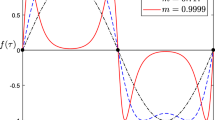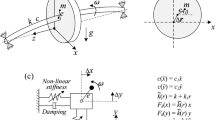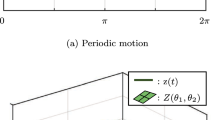Abstract
An autonomous mechanical system with two rotational degrees of freedom, undergoing the action of conservative and nonconservative forces, is considered. The corresponding dynamical system contains changeable parameters that can be treated as amplifying coefficients for control actions. It is required to select the values of these parameters in order to form an autorotation mode in the system that possesses the prescribed properties. We propose an iterative search method for the corresponding values of the parameters. This approach is a modification of the Andronov–Pontryagin method and, unlike the latter, it does not assume that there is a small parameter in the system. We provide an example of the application of the proposed method to a model of a wind turbine: the value of the parameter, ensuring the existence of a mode with a high value of the mechanical power trapped from the flow, is selected. In the dynamical system, an attractor that is a trajectory close to a periodic one corresponds to this mode.





Similar content being viewed by others
REFERENCES
A. A. Andronov, “Les cycles limites de Poincare et la theorie des oscillations auto-entretenues,” C. R. Acad. Sci. 189, 559–561 (1929).
A. A. Andronov, E. A. Leontovich, I. I. Gordon, and A. G. Maier, Theory of Bifurcations of Dynamic Systems on a Plane (Nauka, Moscow, 1967; Israel Program for Scientific Transl., Jerusalem, 1971).
L. D. Akulenko, D. D. Leshchenko, and F. L. Chernous’ko, “ Fast motion of a heavy rigid body aboud a fixed point in a resistive medium,” Izv. Akad. Nauk, Mekh. Tverd. Tela, No. 3, 5–13 (1982).
E. S. Shalimova, “Steady and periodic modes in the problem of motion of a heavy material point on a rotating sphere (the viscous friction case),” Mosc. Univ. Mech. Bull. 69 (4), 89 (2014).
Yu. D. Selyutskiy, “Dynamics of an elastically mounted wing in flow,” AIP Conf. Proc. 2046, 020085-1 (2018).
M. Z. Dosaev, L. A. Klimina, B. Ya. Lokshin, Yu. D. Selyutskii, and E. S. Shalimova, “On the autorotation modes of a double-rotor Darrieus wind turbine,” Mech. Solids, No. 1 (2021, in press).
L. A. Klimina, “Method for constructing periodic solutions of a controlled dynamic system with a cylindrical phase space,” J. Comput. Syst. Sci. Int. 59, 139 (2020).
V. M. Volosov, “The method of averaging,” Dokl. Akad. Nauk SSSR 137, 21–24 (1961).
R. E. Kondrashov and A. D. Morozov, “On global behaviour of the solutions of system of two Duffing—Van der Pole equations,” Nelin. Dinam. 7, 437–449 (2011).
K. Kamiyama, M. Komuro, and T. Endo, “Bifurcation of quasi-periodic oscillations in mutually coupled hard-type oscillators: Demonstration of unstable quasi-periodic orbits,” Int. J. Bifurc. Chaos 22, 1230022 (2012).
F. Schilder, H. M. Osinga, and W. Vogt, “Continuation of quasi-periodic invariant tori,” SIAM J. Appl. Dynam. Syst. 4, 459–488 (2005).
T. S. Parker and L. O. Chua, Practical Numerical Algorithms for Chaotic Systems (Springer, New York, 1989).
Chr. Kaas-Petersen, “Computation of quasiperiodic solutions of forced dissipative systems,” J. Comput. Phys. 58, 395–408 (1985).
N. N. Bogolyubov, Yu. A. Mitropol’skii, and A. M. Samoilenko, The Method of Accelerated Convergence in Nonlinear Mechanics (Nauk. Dumka, Kiev, 1969) [in Russian].
J. Bush, M. Gameiro, S. Harker, H. Kokubu, K. Mischaikow, I. Obayashi, and P. Pilarczyk, “Combinatorial-topological framework for the analysis of global dynamics,” Chaos 22, 047508 (2012).
K. Kamiyama, M. Komuro, and T. Endo, “Algorithms for obtaining a saddle torus between two attractors,” Int. J. Bifurc. Chaos 23, 1330032 (2013).
B. Zhou, F. Thouverez, and D. Lenoir, “A variable-coefficient harmonic balance method for the prediction of quasi-periodic response in nonlinear systems,” Mech. Syst. Signal Process. 64, 233–244 (2015).
G. Chen and J. F. Dunne, “A fast continuation scheme for accurate tracing of nonlinear oscillator frequency response functions,” J. Sound Vibr. 385, 284–299 (2016).
A. M. Samoilenko, “Numerical analytical method of investigating periodic systems of ordinary differential equations. I,” Ukr. Mat. Zh. 17 (04), 82–93 (1965).
A. A. Grin’ and S. V. Rudevich, “Dulac–Cherkas test for determining the exact number of limit cycles of autonomous systems on the cylinder,” Differ. Equat. 55, 319 (2019).
L. S. Pontryagin, “On dynamical systems close to Hamiltonian systems,” Zh. Eksp. Teor. Fiz. 4 (9), 883–885 (1934).
L. A. Cherkas, A. A. Grin’, and V. I. Bulgakov, Constructive Methods for Studying Limit Cycles of Second-Order Autonomous Systems (Numerical-Algebraic Approach) (GrGU, Grodno, 2013) [in Russian].
A. M. Formalskii, Stabilization and Motion Control of Unstable Objects (Walter de Gruyter, Berlin, Boston, 2015).
A. S. Kravets, Characteristics of Aviation Profiles (Gos. Izd. Oboron. Prom-sti, Moscow, 1939) [in Russian].
M. Z. Dosaev, V. A. Samsonov, Yu. D. Selyutskii, Wen-Lung Lu, and Ching-Huei Lin, “Bifurcation of operation modes of small wind power stations and optimization of their characteristics,” Mech. Solids 44, 214 (2009).
L. A. Klimina and E. S. Shalimova, “Dual-propeller wind turbine with a differential planetary gear,” Mekhatron. Avtomatiz. Upravl. 18, 679–684 (2017).
M. V. Ishkhanyan and L. A. Klimina, “Wind turbine of the Savonius–Magnus type with conical blades: Dynamics and control,” J. Comput. Syst. Sci. Int. 59 (4), 630–638 (2020).
M. Z. Dosaev, L. A. Klimina, Yu. D. Selyutskiy, and E. S. Shalimova, “Twin wind turbine powered by Magnus effect,” Vestn. Mosk. Univ., Ser. 1: Mat., Mekh., No. 4, 65–69 (2020).
L. A. Klimina, “Method for finding periodic trajectories of centrally symmetric dynamical systems on the plane,” Differ. Equations 55, 159 (2019).
L. A. Klimina and Yu. D. Selyutskiy, “Method to construct periodic solutions of controlled second-order dynamical systems,” J. Comput. Syst. Sci. Int. 58, 503 (2019).
Funding
This study is supported by the Russian Foundation for Basic Research (grant no. 18-31-20029).
Author information
Authors and Affiliations
Corresponding author
Additional information
Translated by A. Muravnik
Rights and permissions
About this article
Cite this article
Klimina, L.A. Method for Forming Autorotations in Controllable Mechanical System with Two Degrees of Freedom. J. Comput. Syst. Sci. Int. 59, 817–827 (2020). https://doi.org/10.1134/S1064230720060064
Received:
Revised:
Accepted:
Published:
Issue Date:
DOI: https://doi.org/10.1134/S1064230720060064




